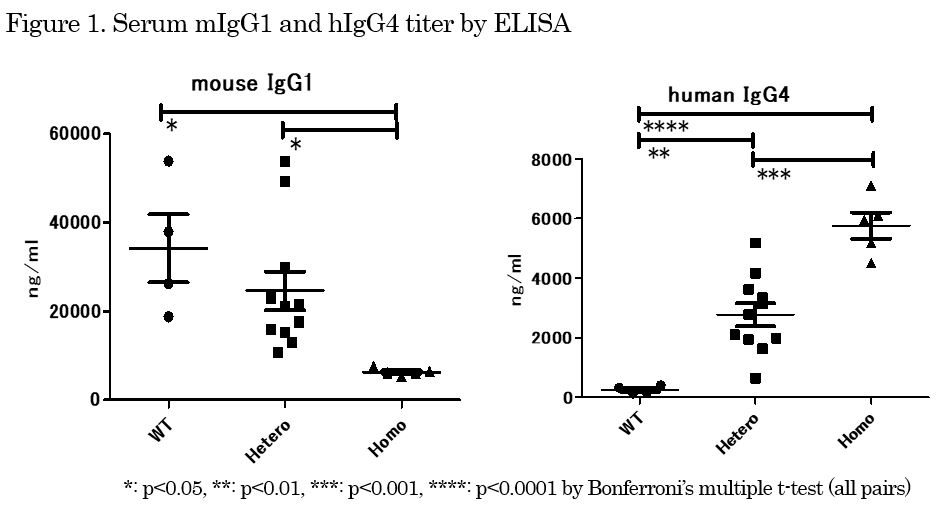Session Information
Session Type: ACR Poster Session B
Session Time: 9:00AM-11:00AM
Background/Purpose: IgG4-related disease (IgG4-RD) is a disorder characterized by elevated serum IgG4 concentration and infiltration of IgG4-positive plasma cells into affected organs, however, the role of IgG4 in the pathophysiology of IgG4-RD is not sufficiently elucidated. Although animal models are required, mice only have IgG1, 2 and 3 subclasses but no IgG4. Therefore, we invented human IgG4 (hIgG4)-knock-in (KI) mice and evaluated their phenotypes.
Methods: The hIgG4 gene is inserted in the cite of mouse IgG1 (mIgG1) gene, which is promoted by Th2 cells associated with the pathophysiology of IgG4-RD. In order to preserve the rearrangement system of VDJ region of IgH gene, constant region of hIgG4 gene was only transfected into ES cells of C57BL/6 mice by gene targeting method. 1) We quantitated levels of mRNA extracted from spleens of homozygous (Homo) and heterozygous (Hetero) IgG4-KI mice by quantitative PCR method. 2) Serum IgG4 levels in Homo, Hetero and wild-type (WT) mice were quantitated by ELISA and turbidimetric immunoassay (TIA) used in daily clinics. 3) To enhance the production of IgG4, we established MRL-lpr/IgG4-KI mice and analyzed them by ELISA and flow cytometry (FCM).
Results: 1) Expression of hIgG4 mRNA, mIgG1 mRNA and hIgG4+mIgG1 mRNA were detected in the spleen of Homo, WT and Hetero mice, respectively. 2) hIgG4, mIgG1 and hIgG4+mIgG1 proteins were detected in sera of Homo, WT and Hetero mice, respectively (Fig. 1). Serum hIgG4 level in Homo mice was 7.0 mg/dL by TIA (Table 1). 3) Serum hIgG4 level in MRL-lpr/IgG4-KI Homo mice was increased to 289 mg/dL. We detected the spleen cells that express IgG4 on surface by FCM.
Conclusion: The transfected IgG4 gene seemed to work physiologically, as we confirmed secretory IgG4 in blood and membranous IgG4 on spleen cells in the mice. Serum IgG4 level was high in MRL-lpr/IgG4-KI mice. Their histopathology is to be examined.
Table 1. Serum hIgG4 titer by TIA
|
|
B6/WT |
B6/IgG4-KI Homo |
MRL-lpr |
MRL-lpr/IgG4-KI |
|
hIgG4 (mg/dL) |
Not detected |
7.0 |
Not detected |
289 |
To cite this abstract in AMA style:
Gon Y, Yoshifuji H, Kitagori K, Nakajima T, Murakami K, Nakashima R, Ohmura K, Mimori T. Invention and Phenotypic Evaluation of Human IgG4-Knock-in Mice [abstract]. Arthritis Rheumatol. 2017; 69 (suppl 10). https://acrabstracts.org/abstract/invention-and-phenotypic-evaluation-of-human-igg4-knock-in-mice/. Accessed .« Back to 2017 ACR/ARHP Annual Meeting
ACR Meeting Abstracts - https://acrabstracts.org/abstract/invention-and-phenotypic-evaluation-of-human-igg4-knock-in-mice/

